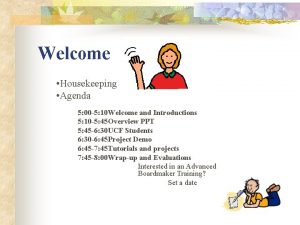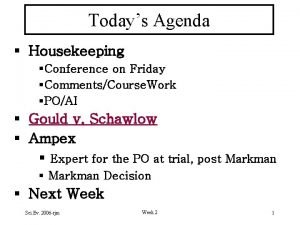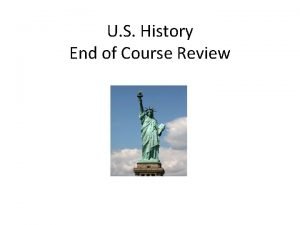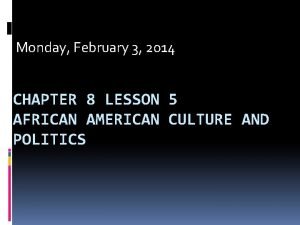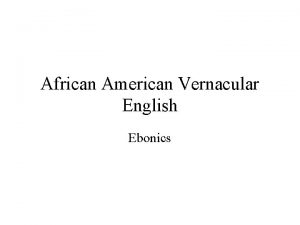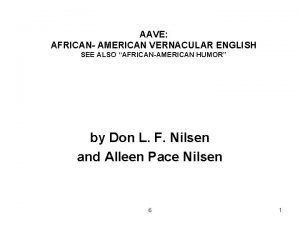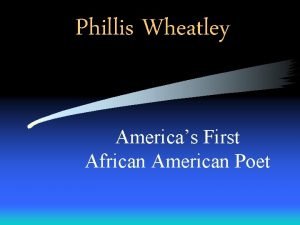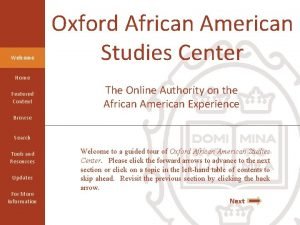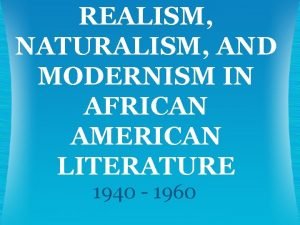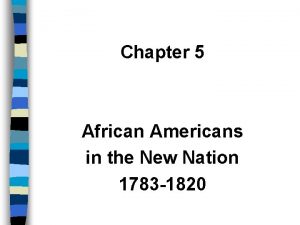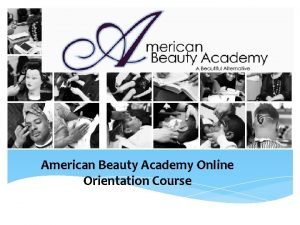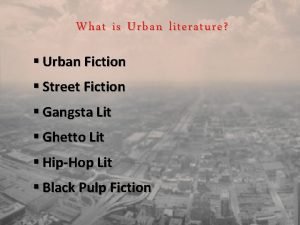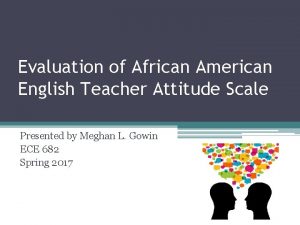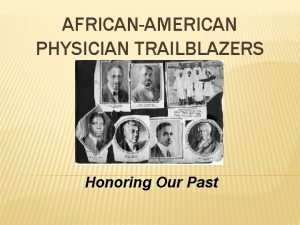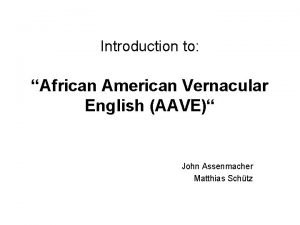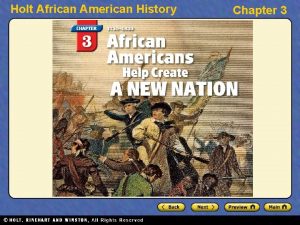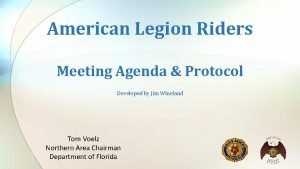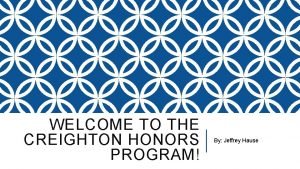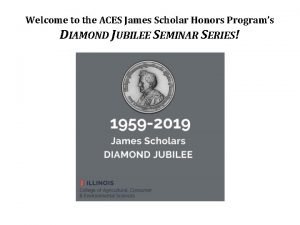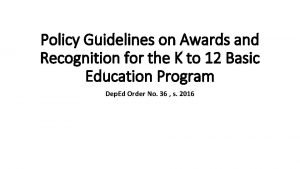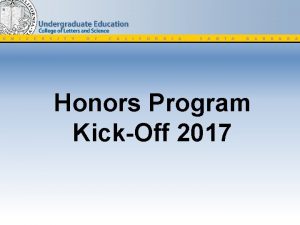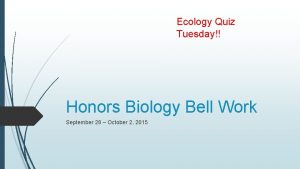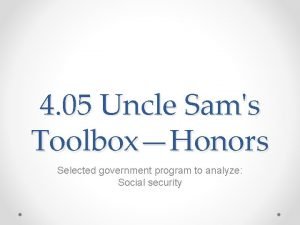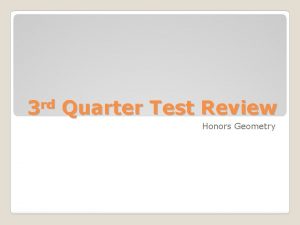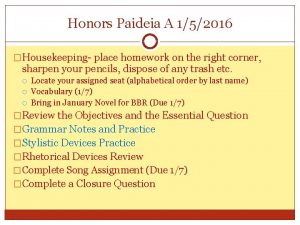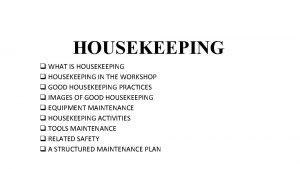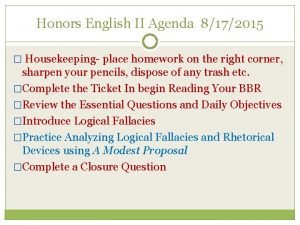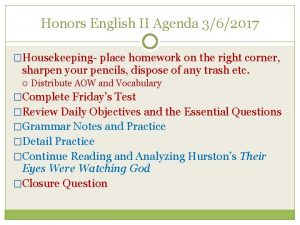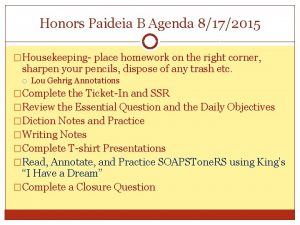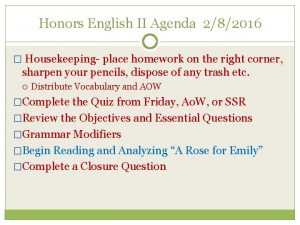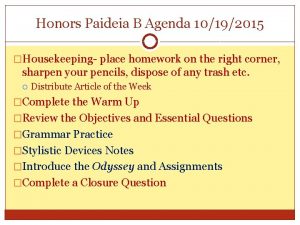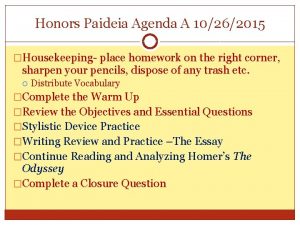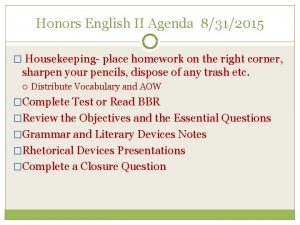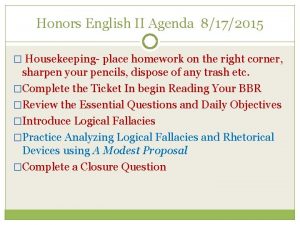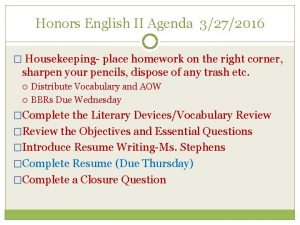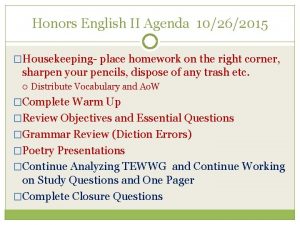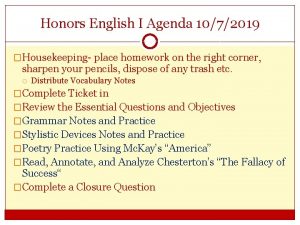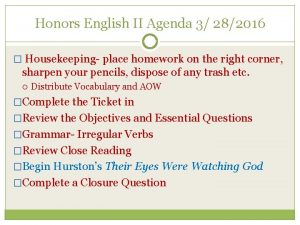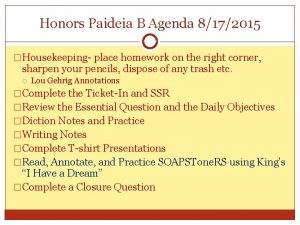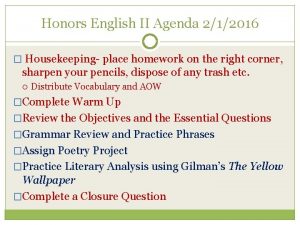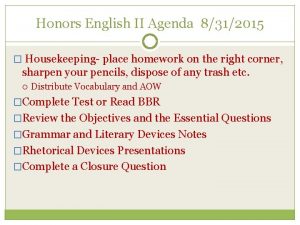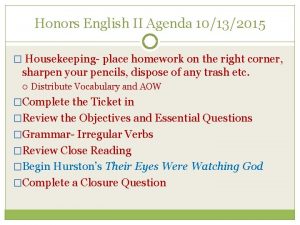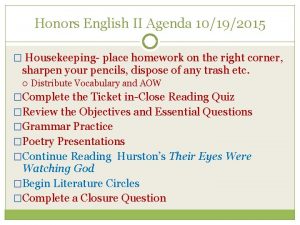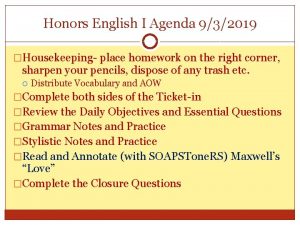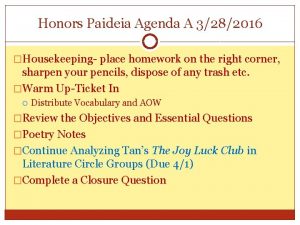Honors African American Lit Agenda 152016 Housekeeping place































- Slides: 31

Honors African American Lit Agenda 1/5/2016 �Housekeeping- place homework on the right corner, sharpen your pencils, dispose of any trash etc. Locate your assigned seat (alphabetical order by last name) Distribute Syllabus �Complete Warm Up �Review the Daily Objectives and Essential Questions �Review the Syllabus for the Class �Review Close Reading and SOAPSTone. RS �Practice Annotating and Close Reading using Dick Gregory “Shame”

Essential Questions �How can the values of the author influence theme? �How can art and literature be a vehicle for social change? �How do persons create a sense of self? �What essential human freedoms should be accorded to all people? �How are works, even visionary ones, still a product of the historical environment in which they were written? �What is the importance of reputation and appearance?

Objectives: �Analyze how an author’s choices concerning how to structure specific parts of a text contribute to its overall structure and meaning as well as its aesthetic impact. �Demonstrate knowledge of foundational works of African American literature, including how two or more texts from the same period treat similar themes or topics. �Cite strong and thorough textual evidence to support analysis of what the text says explicitly as well as inferences drawn from the text, including determining where the texts leaves matters uncertain.

Review the Following Documents: �Review the SOAPSTone. RS document �Read “How to do a Close Reading” Annotate the Text Complete SOAPSTone. RS

Quick Write �Use the following information to create a character description including the person’s motivation, age, circumstances, and personality: �Pokes classmates �Eats paste �Doesn’t answer any the instructor’s questions (on any topic) �Steals portions of classmates’ lunches

Annotating Review Is… Is not… Questions- about things you don’t Identification- recognizing a simile is of understand things you are trying to little help, what is more important is predict why the author is using it Interpretations-meaning or depth that requires thinking or inferences and putting information together Personal Reactions- your opinion does not count; the focus should be on analysis based on information in the text Summary-putting information into your Symbols- putting a star or underling a own words or paraphrasing information passage will not help you remember its in the margins especially after finishing importance a section of the text. Patterns- connecting sequences, Over Highlighting-you are not hear to oppositions, repeating images, symbols, color; if everything is important than words, other literary devices etc. nothing is Words-unique diction or syntax

After you review close reading and annotating: �Read annotate (using SOAPSTone. RS) the text “Shame, ” by Dick Gregory.

With your shoulder sister, answer the following questions: 1. 2. 3. 4. 5. 6. The narration begins in paragraph 3, following two paragraphs of commentary about Helene Tucker, a girl on whom the narrator had a crush. What is the purpose of the preliminary paragraphs? What dominant impression is always in the background of the narration? Why? Beginning with paragraph 9, the narrator adds conversation to the narration? What is the effect of this technique? What is the main theme in this story? Is it implied or stated? In paragraph 5, what is the purpose of repeating the word “pregnant? ” What does the author mean? Why is it important to tell our own story?

Honors African American Lit Agenda 1/6/2016 �Housekeeping- place homework on the right corner, sharpen your pencils, dispose of any trash etc. �Complete Warm Up-Ticket In �Review the Essential Questions and Daily Objectives �Introduce Critical Theory Notes �Practice Literary Analysis using Wright’s “The Man Who Was Almost a Man”

Essential Questions �How can the values of the author influence theme? �How can art and literature be a vehicle for social change? �How do persons create a sense of self? �What essential human freedoms should be accorded to all people? �How are works, even visionary ones, still a product of the historical environment in which they were written? �What is the importance of reputation and appearance?

Objectives: �Analyze how an author’s choices concerning how to structure specific parts of a text contribute to its overall structure and meaning as well as its aesthetic impact. �Demonstrate knowledge of foundational works of African American literature, including how two or more texts from the same period treat similar themes or topics. �Cite strong and thorough textual evidence to support analysis of what the text says explicitly as well as inferences drawn from the text, including determining where the texts leaves matters uncertain.

Literary Criticism � Literary criticism is the evaluation, analysis, description, or interpretation of literary works. It is usually in the form of a critical essay. The initial focus must be on the words of the text (diction) and the structure of the text as much as possible. � A critic understands that the form of each literary work is unique, a particular combination of elements arranged for a particular purpose. Criticism begins with a close reading of a text and in addition to the diction and structure, the reader must consider plot, character, setting, pint of view, and the other elements of fiction. � Each element is purposefully included in the text and consequently, the critic tries to figure out how all of these elements are related (everything from imagery to point of view) and helps to develop the central theme.

“New” Criticism � An analytic literary criticism that is marked by concentration on the language, imagery, and emotional or intellectual tensions/oppositions in literary works � Each text is considered autonomous- history, biography, psychology, and the reader’s private experiences/prior knowledge are irrelevant � Each text has a central unity (theme). The responsibility of the reader is to discover this unity by examining what ways each part of the text (tone, imagery, oppositions, syntax, structure, etc. ) contributes to theme. � Key questions: 1. 2. 3. What did the author say? How did the author say it? What does it really mean?

Oppositions- Review � What is “opposition? ” Some people call opposition conflict but that is too narrow. Opposition occurs when any pair of elements contrast sharply. Another way to think about opposition is tension- think of two opposing elements as if they are magnetized poles attracting and repelling each other. � Opposition may be as blatant as “night” and “day” or it may be less obvious: a character who is naïve and a character who is sophisticated. Opposition may be between an author’s style and his subject- for example a formal, elevated style that is heavy on analysis in a story about a hog farmer. � Opposition may be a character- A foil is a character serves to highlight one or more attributes of another character, often the protagonist, by providing a contrast.

Ethnic Criticism �Unlike New Criticism that considers the text in isolation, in Ethnic Criticism focuses on race and ethnicity as the basis from which to examine literature. �This perspective is of particular importance in American literature because of its diversity. Readers must examine people of color are portrayed by the dominant society as well as in works written by groups who have traditionally been oppressed. �It must examine the way in which the persona of nonwhite people was purposefully constructed in the United States and what purpose this fabricated presence served>

Questions to Consider �Where, in what ways, and to what ends does race appear in dominant American culture and shape interactions? �How are stereotypes created and purposefully delivered to promote assumptions about a particular race or ethnicity? �What does the inclusion or exclusion of people of color do to and for a work? �In what way is African American literature reactionary? Self defining? Paradoxical?

Assignment �Read annotate (using SOAPSTone. RS) the short story, “The Man Who Was Almost a Man. ”

Questions 1. 2. 3. 4. How does Wright establish the point of view of his protagonist in the beginning of the story. How does he invite the reader to understand the last sentence of paragraph 1? What context do the events before the narrative opens provide here? What seems to be the rationale behind Wright’s phonetic spelling? What do the those spelled in the usual way (such as “little” in the last sentence of the 1 st paragraph) reveal? How does race impact the characters in the story? What assumptions about race does the author manipulate to achieve suspense? What is theme? What literary devices are used to enhance it?

Honors African American Lit Agenda 1/7/2016 �Housekeeping- place homework on the right corner, sharpen your pencils, dispose of any trash etc. �Complete Warm Up-Ticket In �Review the Essential Questions and Daily Objectives �Continue Critical Theory Notes �Read analyze Welty “A Worn Path”

Essential Questions �How can the values of the author influence theme? �How can art and literature be a vehicle for social change? �How do persons create a sense of self? �What essential human freedoms should be accorded to all people? �How are works, even visionary ones, still a product of the historical environment in which they were written? �What is the importance of reputation and appearance?

Objectives �Analyze how an author’s choices concerning how to structure specific parts of a text contribute to its overall structure and meaning as well as its aesthetic impact. �Demonstrate knowledge of foundational works of African American literature, including how two or more texts from the same period treat similar themes or topics. �Cite strong and thorough textual evidence to support analysis of what the text says explicitly as well as inferences drawn from the text, including determining where the texts leaves matters uncertain.

Feminist Criticism � Feminist criticism is concerned with ". . . the ways in which literature (and other cultural productions) reinforce or undermine the economic, political, social, and psychological oppression of women" (Tyson). This school of theory looks at how aspects of our culture are inherently patriarchal (male dominated) and ". . . this critique strives to expose the explicit and implicit misogyny in male writing about women" (Richter 1346). This misogyny, Tyson reminds us, can extend into diverse areas of our culture: "Perhaps the most chilling example. . . is found in the world of modern medicine, where drugs prescribed for both sexes often have been tested on male subjects only" (83). � Feminist criticism is also concerned with less obvious forms of marginalization such as the exclusion of women writers from the traditional literary canon: ". . . unless the critical or historical point of view is feminist, there is a tendency to under-represent the contribution of women writers" (Tyson 82 -83).

Questions � How is the relationship between men and women portrayed? � What are the power relationships between men and women (or characters assuming male/female roles)? � How are male and female roles defined? What constitutes masculinity and femininity? How do characters embody these traits? � Do characters take on traits from opposite genders? How so? How does this change others’ reactions to them? � What does the work reveal about the operations (economically, politically, socially, or psychologically) of patriarchy? � What does the work imply about the possibilities of sisterhood as a mode of resisting patriarchy? As reinforcing patriarchy? � How do the experiences of women vary based on ethnicity? Is this evident in the work?

Marxist Theory �Based on theories of Karl Marx (and so influenced by philosopher Georg Wilhelm Friedrich Hegel), this school concerns itself with class differences, economic and otherwise, as well as the implications and complications of the capitalist system: "Marxism attempts to reveal the ways in which our socioeconomic system is the ultimate source of our experience" (Tyson 277). �Theorists working in the Marxist tradition, therefore, are interested in answering the overarching question, whom does it [the work, the effort, the policy, the road, etc. ] benefit? The elite? The middle class? And Marxists critics are also interested in how the lower or working classes are oppressed - in everyday life and in literature.

Questions �Whom does it benefit if the work or effort is accepted/successful/believed, etc. ? �Which class does the work claim to represent? �What values does it reinforce? What values does it subvert? �What conflict can be seen between the values the work champions and those it portrays? �What social classes do the characters represent? �How do characters from different classes interact or conflict?

Assignment �Read annotate (using SOAPSTone. RS) the short story, “Girl. ”

Questions 1. 2. 3. 4. 5. What is the plot structure of the story? What is the conflict in the plot? When is the conflict resolved? Analyze Phoenix’s language? What is conveyed through her speech? What details indicate that Phoenix Jackson is slightly senile and therefore not always in touch with reality? What roles do race, gender, and social class play in this work? Explain. Would the story be different if it was told by an African American woman? By a male?

Honors African American Lit 1/8/2016 �Housekeeping- place homework on the right corner, sharpen your pencils, dispose of any trash etc. �Complete Warm Up-Ticket In �Review the Essential Questions and Daily Objectives �Read and Analyze Kincaid’s “Girl”

Essential Questions �How can the values of the author influence theme? �How can art and literature be a vehicle for social change? �How do persons create a sense of self? �What essential human freedoms should be accorded to all people? �How are works, even visionary ones, still a product of the historical environment in which they were written? �What is the importance of reputation and appearance?

Objectives �Analyze how an author’s choices concerning how to structure specific parts of a text contribute to its overall structure and meaning as well as its aesthetic impact. �Demonstrate knowledge of foundational works of African American literature, including how two or more texts from the same period treat similar themes or topics. �Cite strong and thorough textual evidence to support analysis of what the text says explicitly as well as inferences drawn from the text, including determining where the texts leaves matters uncertain.

Assignment �Read annotate Kincaid’s “Girl. ” �In small groups, analyze the text using your assigned critical theory (use the questions from the notes).
 Background color
Background color Housekeeping agenda
Housekeeping agenda Agenda sistemica y agenda institucional
Agenda sistemica y agenda institucional African american fighter pilots
African american fighter pilots Chapter 8 lesson 5 african american culture and politics
Chapter 8 lesson 5 african american culture and politics Aave syntax
Aave syntax African american vernacular english
African american vernacular english Prentice hall african american history
Prentice hall african american history First african american poet
First african american poet Oxford african american studies center
Oxford african american studies center Realism naturalism modernism in african american literature
Realism naturalism modernism in african american literature African american cinema history
African american cinema history Chapter 5 african american in the new nation
Chapter 5 african american in the new nation African american beauty academy
African american beauty academy Urban literature
Urban literature African american english teacher
African american english teacher African american doctors in kansas city
African american doctors in kansas city African american vernacular english example
African american vernacular english example Holt african american history
Holt african american history American legion meeting agenda
American legion meeting agenda Place place value and period
Place place value and period A disturbance that transfers energy
A disturbance that transfers energy A wave is a disturbance that transfers energy
A wave is a disturbance that transfers energy Creighton university honors program
Creighton university honors program James scholar uiuc aces
James scholar uiuc aces Deped order no. 36 s. 2016
Deped order no. 36 s. 2016 Ucsb urca
Ucsb urca Honors physics semester 2 review
Honors physics semester 2 review Honors biology ecology test
Honors biology ecology test 4.05 honors economics
4.05 honors economics Honors geometry quadrilaterals test
Honors geometry quadrilaterals test Honors earth science
Honors earth science
